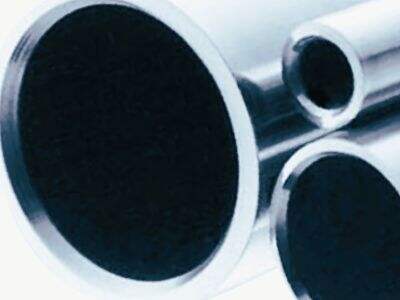ເທີງທຸ່ມແມ່ນວັດຖຸຖານທີ່ພວກເຮົາຈະພົບເຫັນໃນສະຖານທີ່ຫຼາຍປະເພດ. ມັນມີຢູ່ໃນສະຖານທີ່ສ້າງ, ໂດຍທີ່ສະຖານທີ່ນັ້ນຖືກສ້າງຂຶ້ນ, ໃນເສັ້ນທາງຄັນສົ່ງ, ໂດຍທີ່ມັນສົ່ງນ້ຳ, ເຫືອ, ແລະວັດຖຸອື່ນໆ. ຖ້າທ່ານກຳລັງຜະລິດເທີງທຸ່ມຂອງທ່ານเอง, ຫຼັງຈາກທີ່ມັນຖືກສ້າງຂຶ້ນມາ, ມັນຕ້ອງໄດ້ຮັບການດູແລພິเศษ. ກໍານົດເຫຼົ່ານີ້ແມ່ນເພື່ອສັກສີວ່າເທີງທຸ່ມເຫຼົ່ານັ້ນເປັນສະພາບ, ນັບຄຸນ, ແລະແຂງ. ການດູແລສ່ວນຫຼາຍຂອງການດູແລນີ້ແມ່ນກ່ຽວກັບສູ້ນຂອງເທີງທຸ່ມ. ໃນບົດນີ້, ພວກເຮົາຈະອະທິບາຍວ່າເປັນເຫດໃຫ້ສູ້ນຂອງເທີງທຸ່ມຕ້ອງໄດ້ຮັບການດູແລຫາຍກວ່າໃນການຜະລິດ.
ເພື່ອປ້ອງກັນສະເພາແຫ່ງຂາຍຫຼຸດຂອງທ່ອງເຄື່ອງສົ່ງຕາມພື້ນຖານ
ແຫ່ງຂາຍທ່ອງເຄື່ອງສົ່ງແມ່ນສ່ວນທີ່ເຊື່ອມຕໍ່ຂອງ 1 1 2 stainless steel pipe ໄປຫາທ່ອງເຄື່ອງສົ່ງຫຼຸດອື່ນຫຼືອຸປະກອນ. ສ່ວນທີ່ເຊື່ອມຕໍ່ເປັນຈຸດທີ່ສຳຄັນເสมົ່າ, ເພາະວ່າສ່ວນນີ້ແມ່ນສ່ວນທີ່ອ່ອນແລະອ່ານທີ່ສຸດຂອງທ່ອງເຄື່ອງສົ່ງ. ມັນບໍ່ແມ່ນນ້ອຍໃຫຍ່ທີ່ຈະໄດ້ຮັບການເສຍແຫຼວຢ່າງແປດແປງ. ສົ່ງຜົນທີ່ບໍ່ຖືກການດູແລ, ມັນສາມາດເສຍແຫຼວຫຼືເສຍແຫຼວໄດ້. ນີ້ສາມາດເຮັດໃຫ້ມີນ້ຳຫຼິ້ນ, ການເສຍແຫຼວ, ແລະບັນຫາໃຫຍ່ອື່ນໆ. ທ່ອງເຄື່ອງສົ່ງທີ່ມີນ້ຳຫຼິ້ນສາມາດເຮັດໃຫ້ມີບັນຫາຄວາມປອດໄພຫຼາຍແລະສັງເກດຕໍ່ການສົ່ງຜ່ານຂອງວັດຖຸ. ແລະນັ້ນແມ່ນເຫດຜົນທີ່ສຳຄັນເພື່ອມີການດູແລສ່ວນຫາຍຂອງທ່ອງເຄື່ອງສົ່ງ. ມັນແນັງໃຫ້ລະບົບທ່ອງເຄື່ອງສົ່ງທັງໝົດເຮັດວຽກດ້ວຍຄວາມປອດໄພແລະມີຄວາມມັນຄ່າ.
ແນວທີ່ພວກເຮົາດູແລສ່ວນຫາຍຂອງທ່ອງເຄື່ອງສົ່ງ?
ການດູແລສ້າງທັຍຂອງທ່ອຄືກັບວ່າເຮັດໃຫ້ສ້າງທັຍຂອງທ່ອມີຄວາມສະຫງ່າມື້ງ ແລະ ຕຳແໜ່ງປິດສ້າງທັຍໂດຍຜ່ານການເຮັດຫຼາຍຂັ້ນຕອນ. ການດຳເນີນງານນີ້ເປັນການໃຊ້ວິທີ່ຫຼາຍປະເພດ, ເຊັ່ນ: ການຕັດ, ການເຮັດໃຫ້ສ້າງແຈ້ງ, ການເພີມສາຍ, ການປິດ, ແລະ ການແ Thailand. ຂັ້ນຕອນທັງໝົດນີ້ມີຄວາມສຳຄັນເປັນພິเศດ. ເຊັ່ນ: ການຕັດມີຄວາມຮ່ວມມືໃນການເຮັດໃຫ້ສ້າງທັຍຂອງທ່ອມີຮູບແບບທີ່ຖືກຕ້ອງ, ເຊິ່ງການເຮັດໃຫ້ສ້າງແຈ້ງຊ່ວຍໃຫ້ແຈ້ງສ້າງທັຍທີ່ຈະປ່ຽນເປັນຄວາມບໍ່ສຳເລັດໃນການເຮັດວຽກ.
ໂດຍການເຮັດໃຫ້ສ້າງແຈ້ງ, ສ້າງທັຍຈະບໍ່ມີຄວາມສຸກເສີນ, ຄວາມຫຼຸດ, ຫຼື ຄວາມເສຍໄວເທົ່າໃດເມື່ອມັນເຊື່ອມຕໍ່ກັບສ່ວນອື່ນ. ມັນຍັງສຳຄັນທີ່ຈະຕ້ອງແ Thailand ຫຼື ກຳປະສີສ້າງທັຍ, ເພື່ອປ້ອງກັນການເກີດຂອງເສີນ. ອາຍຸຂອງລະບົບທ່ອຈະຫຼຸດລົງຫຼາຍເນື່ອງຈາກເສີນທີ່ເຮັດໃຫ້ຕ້ອງແທນທ່ອໄວກວ່າທີ່ຄວນ. ພວກເຮົາສາມາດແນກນຳວ່າທ່ອຈະຢຸດໄວ້ແລະເຮັດວຽກດີໂດຍການດູແລສ້າງທັຍຂອງທ່ອໃນລັດຖະບານທີ່ຖືກຕ້ອງ.
ວິທີ່ຂອງການດູແລສ້າງທັຍທ່ອເຫຼັກ
ມີປະເພດການຫຼິ້ນທີ່ຕ່າງກັນສຳລັບແຜນສຸດທ້າຍຂອງທ່ອງເຫຼົ້າ ຕົວຢ່າງທີ່ມັນມີຄວາມເປັນຈຸດແຂ່ແລະຄວາມຫຼິ້ນ. ການຫຼິ້ນແມ່ນໜຶ່ງໃນປະເພດທີ່ໄດ້ຮັບຄວາມນິຍົມສູງສຸດ. ການນີ້ເຮັດໂດຍການເຊື່ອມແຜນສຸດທ້າຍຂອງທ່ອງ. ການເຊື່ອມເຫຼົ້ານີ້ສະຫຼັບສູງສຸດ ເພື່ອໃຫ້ທ່ອງເຫຼົ້າສາມາດເຊື່ອມຮ່ວມກັບທ່ອງເຫຼົ້າອື່ນ ຫຼືອົງປະກັນ. ນີ້ແມ່ນສຳຄັນເພາະວ່າການເຊື່ອມນີ້ສາມາດຖືກຕົກລົງໄດ້ທັງໝົດ ທີ່ສາມາດຕໍ່ຕ້ານຄວາມເປັນຈຸດແຂ່ແລະຄວາມຫຼິ້ນ ພຽງແຕ່ບໍ່ສາມາດຖືກແຍກອອກ.
ການເຊື່ອມແຜນສຸດທ້າຍແມ່ນປະເພດອື່ນໆ 1 1 4 galvanized pipe ການຫຼິ້ນແຜນສຸດທ້າຍ. ການເຊື່ອມແຜນສຸດທ້າຍແມ່ນການຕັດແຜນສຸດທ້າຍຂອງທ່ອງເຫຼົ້າເປັນມຸມ. ນີ້ສັງຄັນເພື່ອໃຫ້ພື້ນທີ່ສະຫຼັບສູງສຸດ ເພື່ອໃຫ້ສາມາດແຫຼັງໄດ້. ການເຊື່ອມແຜນສຸດທ້າຍທີ່ຖືກຕ້ອງສັງຄັນເພື່ອໃຫ້ການແຫຼັງທີ່ແຂ່ແລະສາມາດຮັບຄວາມຝູ້ງແລະອຸນຫະພູມສູງ ເພື່ອໃຫ້ລະບົບທ່ອງເຫຼົ້າທັງໝົດສັງຄັນ.
ການປັບປຸງທ່ອງເຫຼົ້າໃນສະຖານະທີ່ດີ
ບໍ່ວິນາທີ່ຫມາຍເປັນແຕ່ໃຫຍ່ ເສັ້ນທາງຂອງເຫຼືອງກໍາລັງຈະດີ ກໍາໄປທີ່ສຸດ ໃນການເຮັດໃຫ້ເສັ້ນທາງເຫຼືອງກໍາລັງເຮັດວຽກໄດ້ດີທີ່ສຸດ ແລະຢູ່ໄດ້ຍາວທີ່ສຸດ. ການເອົາລົ້ມແຜນແລະການເພີ່ມຄວາມສະຫງົບສຳເລັດ ກໍາລັງຈະຫຼຸດຄວາມສົ່ງສັນ ແລະການເສີມເສີມ. ນີ້ອະນຸຍາດໃຫ້ມີການນຳເສີນທີ່ດີ, ແລະຫຼຸດຄວາມສົ່ງສັນ ແລະການເສີມເສີມ. ເພື່ອການເຮັດໃຫ້ເສັ້ນທາງເຫຼືອງກໍາລັງເຮັດວຽກໄດ້ສົງຄາມ ແລະເປັນການປ້ອງກັນເຫຼືອງກໍາລັງຈາກການເສີມເສີມ. ອີງໃຫ້ເສັ້ນທາງເຫຼືອງກໍາລັງເຮັດວຽກໄດ້ສົງຄາມ ແລະເປັນການປ້ອງກັນເຫຼືອງກໍາລັງຈາກການເສີມເສີມ.
ໂດຍເປັນການເຮັດໃຫ້ເສັ້ນທາງເຫຼືອງກໍາລັງ 1 2 galvanized pipe ແຜນແລະການເພີ່ມຄວາມສະຫງົບສຳເລັດ ກໍາລັງຈະຫຼຸດຄວາມສົ່ງສັນ ແລະການເສີມເສີມ. ນີ້ອະນຸຍາດໃຫ້ມີການນຳເສີນທີ່ດີ, ແລະຫຼຸດຄວາມສົ່ງສັນ ແລະການເສີມເສີມ. ເພື່ອການເຮັດໃຫ້ເສັ້ນທາງເຫຼືອງກໍາລັງເຮັດວຽກໄດ້ສົງຄາມ ແລະເປັນການປ້ອງກັນເຫຼືອງກໍາລັງຈາກການເສີມເສີມ.
ພວງກັບ, ຖ້າສຸດທ້າຍຂອງ CFPS ໄດ້ຖືກຮັກษา, ທະຫຼາດແລະຄວາມປອດໄພຂອງມັນກໍ່ຈະຖືກຮັກษา. ການເຮັດວຽກສຸດທ້າຍເປັນການຕັດ, ການເພີ່ມເຊື້ອ, ການໃຫ້ສາຍບັນທຶກ, ແລະການແຜ່. ເຫດການເຫ່່ຍິດນີ້ຊ່ວຍໃຫ້ລົບລາຍລະเอียດ, ອັກຊິເຊີນ, ແລະແນນໃຫ້ແມ່ນຫນ້າວ່າຍ້າຍໄປຢ່າງສະຫງົບສະຫັນ. ການດູແລສຸດທ້າຍຂອງທໍານິກເหลັກແມ່ນການລົງທຶນໃນຊີວິດທີ່ຍຸ່ງຍາວແລະຄວາມປະຕິບັດຂອງລະບົບທໍານິກ. UDREAM ຕັ້ງໃຈທີ່ຈະດູແລສຸດທ້າຍຂອງທໍານິກເຫລັກໃນວິທີທີ່ດີທີ່ສຸດເພື່ອໃຫ້ທຸກສິ່ງເຮັດວຽກໄດ້.

 EN
EN
 AR
AR
 DA
DA
 FR
FR
 DE
DE
 EL
EL
 HI
HI
 IT
IT
 JA
JA
 KO
KO
 PT
PT
 RU
RU
 ES
ES
 SV
SV
 ID
ID
 VI
VI
 MT
MT
 TR
TR
 FA
FA
 AF
AF
 MS
MS
 GA
GA
 BN
BN
 KM
KM
 LO
LO
 LA
LA
 MN
MN
